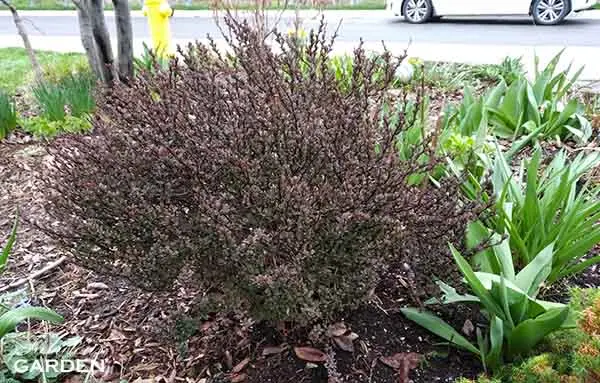Contents
Pruning barberry is an essential procedure in the process of growing shrubs, including barberry. He tolerates a haircut well, because he tends to recover quickly. For some varieties, the annual growth is 30 cm. An attractive bush is used in landscape design, as well as to obtain valuable fruits.
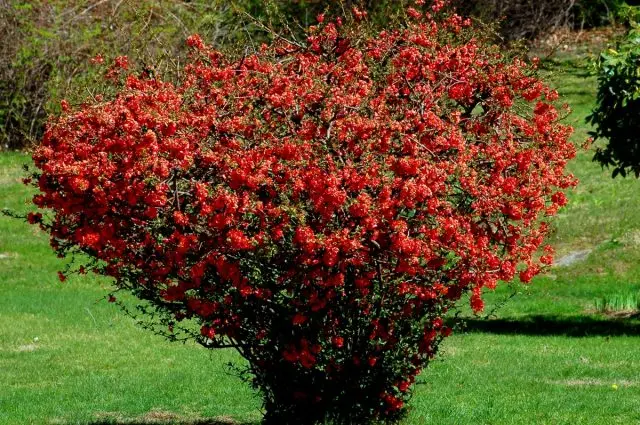
Is it possible to prune barberry bushes
Barberry is a multi-stem shrub with thorns. It grows to a height of 3-4 meters, if not limited. Due to the numerous lateral branches, it grows to the sides. The branches are sprawling, so without regular pruning, impenetrable thickets will turn out on the site.
Another argument for the need for pruning: fruiting and flowering of barberry occurs exclusively on annual shoots. Berries do not appear in the shade of strong thickening. Also pruning and thinning the bush is the prevention of fungal diseases by improving crown ventilation. There is less chance for insects to harm the plant.
When to prune barberry
The timing of the pruning doesn’t really matter. The procedure will be equivalent in spring and autumn. However, there are recommendations. Pruning should begin after harvest and before frost. In the spring you need to have time before the appearance of new leaves. Based on the characteristics of the cultivated plant variety, choose a more suitable period for the pruning procedure. For example, deciduous barberries are pruned in early spring before bud break. Evergreen varieties of barberry are sheared after flowering.
The type of procedure also affects the timing.
- Sanitary pruning is carried out in March-April or September-October.
- The anti-aging procedure is best performed in the spring.
- Formative pruning is planned for the spring for a single planted bush.
If it is necessary to cut a hedge or borders, then the procedure will be performed in 2 stages. The first pruning is done in early June, and the second pruning is performed until mid-August.
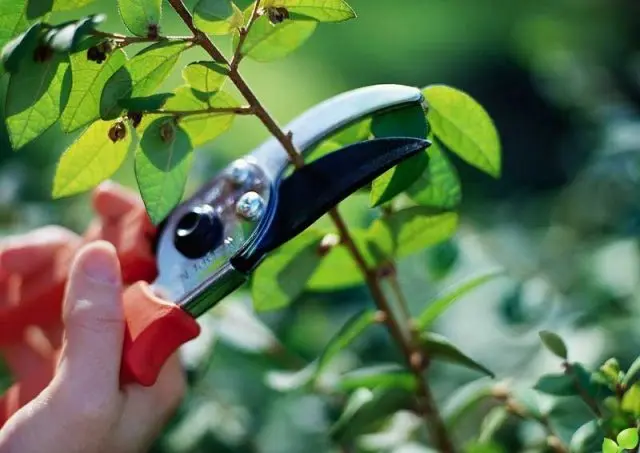
How to prune barberry
The procedure for pruning barberry depends on the purpose for which this technique is carried out. As a rule, 3 pruning options are carried out annually: rejuvenating, sanitary, shaping.
- The purpose of sanitary pruning consists in removing dry, diseased, underdeveloped branches. This event is considered the most important, because it allows you to protect the plant from possible infection with fungi and death from pests. Sanitary cleaning of the bush is recommended to be carried out regularly twice a year. It is necessary to thin out the crown, cut off old shoots and thin processes under the base. Young shoots should not be touched, they should develop, be healthy, long. After all, they affect the quantity and quality of the crop. You can understand that the barberry needs sanitary pruning by making a visual inspection of the bush.
- Rejuvenating pruning barberry is aimed at solving two problems: to increase the number of berries obtained and to improve the decorative properties. In order to obtain a larger yield, branches that no longer bear fruit are eliminated. The procedure must be transferred to strong branches that grow on the same basis. Anti-aging pruning should be carried out only on shrubs that are more than 10 years old. It is not advised to carry out work when the first leaves have already appeared. Usually, the rejuvenation process is performed in the fall, before the first frosts. Old shoots are cut off at the very root. Rejuvenating pruning gives impetus to the emergence of young shoots.
- Gentle crown formation barberry is available even for beginner gardeners. In the first 4-5 years, while the process of forming a bush about flowering takes place, and, accordingly, you can forget about the fruits. Formative pruning is performed after the appearance of ovaries on the bush. For an adult barberry, a rejuvenating procedure is first carried out, and then they proceed to shaping a shrub.
If desired, you can carry out a curly haircut twice during the summer, as the processes grow. New shoots that have reached 10 cm are halved. It is better to start forming with simple geometric shapes, gradually adding a level of complexity.
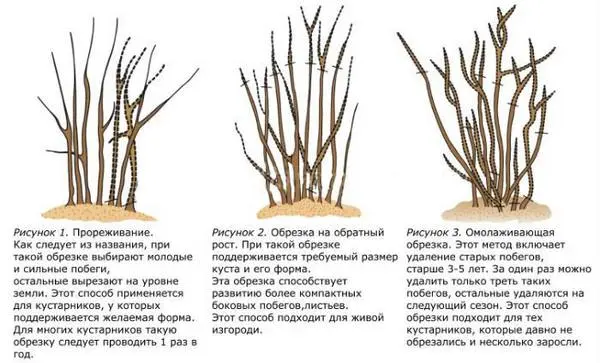
Pruning barberry in spring
Pruning of barberry branches is performed, as a rule, in autumn or spring. The rejuvenating procedure is preferably performed before wintering the bush, after the dry leaves have fallen. Depending on the type of planting, the following preventive measures are taken:
Trimming type | Landing type | Work carried out |
Sanitary | solitary shrub | Remove dry, diseased, broken shoots that have lost their decorative appearance. Thin out the crown of the bush. Pruned branches that did not survive the winter well. Shorten healthy branches. |
Border plantings, hedges | ||
Formative | solitary shrub | Cut off branches that grow close to the ground or strongly protruding to the sides. Regulate the number of shoots in the bush. Shorten annual growths by 6-8 cm. |
Rejuvenating | solitary shrub | Old shoots are shortened at the root. Remove thin, poorly developing branches if the plant has grown strongly. In young shoots, only 1/3 of the length is left. |
Border plantings, hedges |
pruning barberry in summer
It is not necessary to adhere to certain deadlines for pruning barberries. If there is a need to remove dry branches or trim the crown, then it is allowed to do this in the summer. The main thing is that the procedure is as useful as possible.
Trimming type | Landing type | Work carried out |
Sanitary | solitary shrub | If necessary, cut the shoots and leaves damaged by parasites. Remove withered or infected shoots, as well as dry and yellow branches, to preserve the decorative characteristics of the barberry. |
Border plantings, hedges | ||
Formative | Border plantings, hedges | At the beginning of summer, height and width are adjusted using templates. Pruned shoots that go beyond the specified limits. After 2 months, the procedure is repeated to maintain shape. |
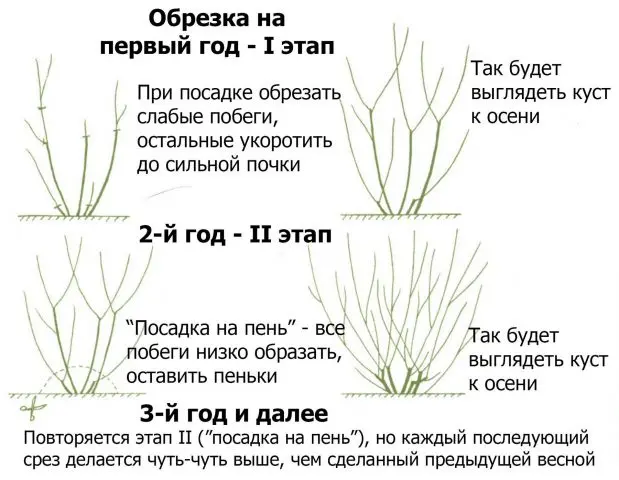
How to form a barberry correctly
The formation of barberry begins in the second year of the life of the shrub. In spring, all branches are shortened by 8-10 cm from the ground. This technique allows you to create a more lush crown by autumn. For the next season, shoots are cut 5 cm higher than the previous ones. In the case of an individual planting, this procedure can be neglected, performing regularly only sanitary pruning. When creating hedges, geometric shapes, curb plantings, this pruning will be an annual necessity.
To give shape, the shrub is formed gradually. First lay 3-4 main, skeletal branches. Over time, the number is increased by adding two more skeletal branches. Thus, due to the different size of the shoots, it is possible to form a pyramidal barberry.
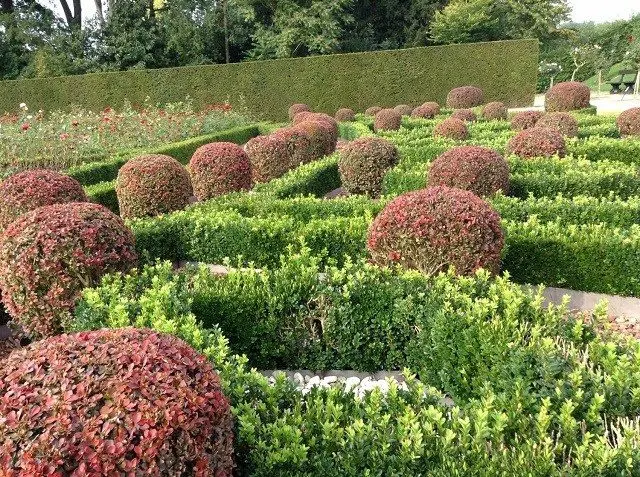
Features of pruning barberry Thunberg
Thunberg barberry is often planted as an ornamental shrub in Our Country. All varieties of this plant are characterized by high rates of frost resistance, unusual leaf color, but most importantly, they are used to decorate the garden. Barberry fruits are inedible.
I require minimal pruning for dwarf varieties. Their average annual growth is 3-5 cm. The crown is slightly adjusted to obtain a more spectacular look. Thunberg’s barberry is used for border plantings. As for trimming procedures, they are intended not only for decorative, but also for sanitary purposes.
- The first pruning of the barberry is carried out at the age of 10 years, the next – annually.
- Given the thorniness of the plant, it is worth doing the work in compliance with the rules of individual safety. It is advisable to wear long protective gloves. From the tool, a sharp garden pruner and a hacksaw are useful.
- Pruning begins with the removal of the lower branches, which are located near the soil itself.
- Shorten the shoots to a developed kidney.
- Large sections must be treated with garden pitch.
- A crown is formed by cutting out part of the young shoots.
- Sections are made at an angle as close as possible to the kidney. The surface should be smooth, without burrs and crushing of the bark.
- Lateral branches are cut straight along the annular influx at the base of the shoot.
- To make the rejuvenating pruning easier for the barberry, it is carried out in several stages.
- From the area where the barberry grows, the remains of cut shoots, dry foliage and other organic debris should be carried away. Such cleaning allows you to avoid getting infections and parasites inside the shrub.
- When planting, healthy shoots are shortened and weak shoots are pruned.
- In autumn, after pruning, they are fed with potassium-phosphorus fertilizers.
- Low-growing varieties of barberry should not be specially formed. For them, it is enough to cut dry, diseased branches.
Conclusion
Pruning barberry is not only a decorative design of the shrub, but also a procedure that maintains the health of the plant at the proper level. Indeed, in heavily thickened crowns, poor ventilation, which provokes the occurrence of infections and the development of parasites. Of course, pruning requires certain skills. However, difficulties should not be afraid. With each new season and shrub experience will accumulate.










